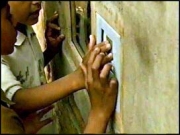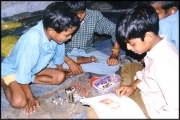
|

|
|||||||||||||||||||||||||||||||||
|
||||||||||||||||||||||||||||||||||
|
A New Way to Learn
Traditional Computer Based Learning (CBL) methods typically rely on one-way transmission of information. These methods are seen as extensions of classroom learning and thus viewed by children as restrictive. Consequently, results from such CBL initiatives have, at best, been mixed.
In Contrast, Hole-in-the-wall Learning Stations seek to create a new paradigm in the learning process by providing unrestricted computer access to groups of children in an open playground setting. We believe that such an open setting will use child’s natural curiosity to stimulate learning. The essential features are:
Optimum utilization of Learning station - In a traditional computer lab setting, pedagogy is ‘instruction based’ where focus is on dissemination of information. Moreover the access to computer is restricted by average usage time available per user (more so by the ‘scarcity mentality’). As opposed to this, HiWEL Learning Stations rely more on exploratory learning where children who can freely experiment on the Learning Station. Again, groups of children access the Learning Station leading to twin advantages of collaborative learning and multiple children using the Learning Stations at the same time. This leads to much greater impact on children than a traditional lab based setting. Integration with the school system - A big advantage of the HiWEL learning station is that it fits in nicely with traditional schooling and seeks to reinforce structured learning through peer discussions, increased curiosity and better retention. In schools where the Learning Stations were installed, some teachers have reported improved retention and increased receptivity among children. There have also been early indications of constructive in-class behavior and better scores among kids using the Learning Stations. HiWEL Learning Stations thus seek to enhance the effectiveness of overall learning experience by integrating with the schooling system. Learning to learn – Apart from addressing the issue of education skills, HiWEL Learning Stations address a more fundamental skill set –the Process of Learning itself. By encouraging children to explore the Learning Station, it seeks to impart them with problem solving skills and an ability to think critically. So, while a child learns how to use educational software, she also develops an ability to analyze, synthesize and evaluate information which in turn builds her long term ability to learn. Projects by Children - The Learning Stations are used for various real life projects. These projects are designed to engage children in authentic tasks relevant to their daily lives. Moreover they are designed to be locally relevant so that children can directly relate to them. The children can then use the Learning Stations for culling out information, compiling data and preparing reports. This will help develop their personalities while engaging them in tasks which could be of use to local community. |
|
|||||||||||||||||||||||||||||||||
|
© Hole-in-the-Wall Education Ltd. 2015 | Privacy Policy | Terms of Use |
||||||||||||||||||||||||||||||||||



